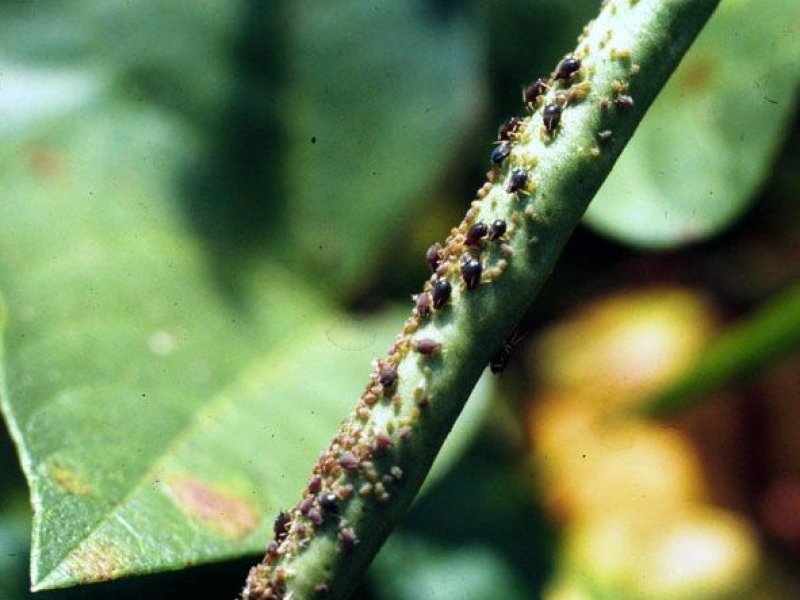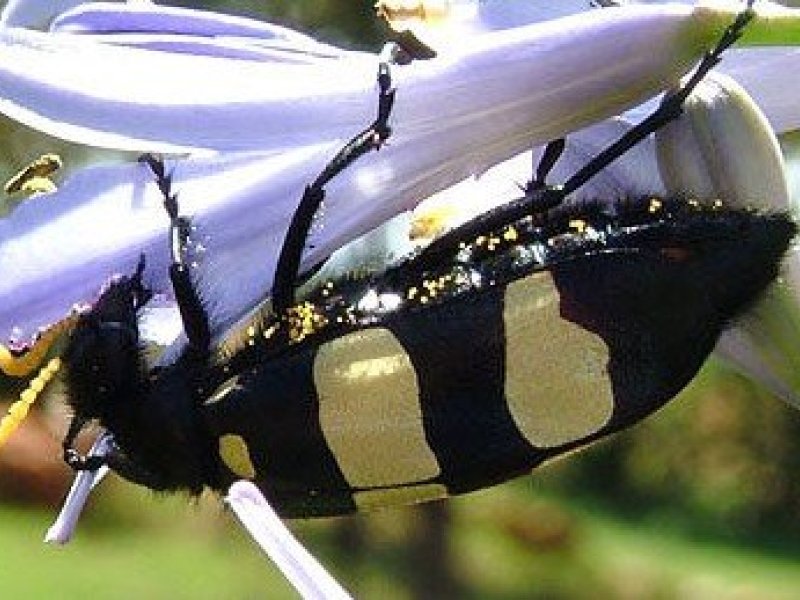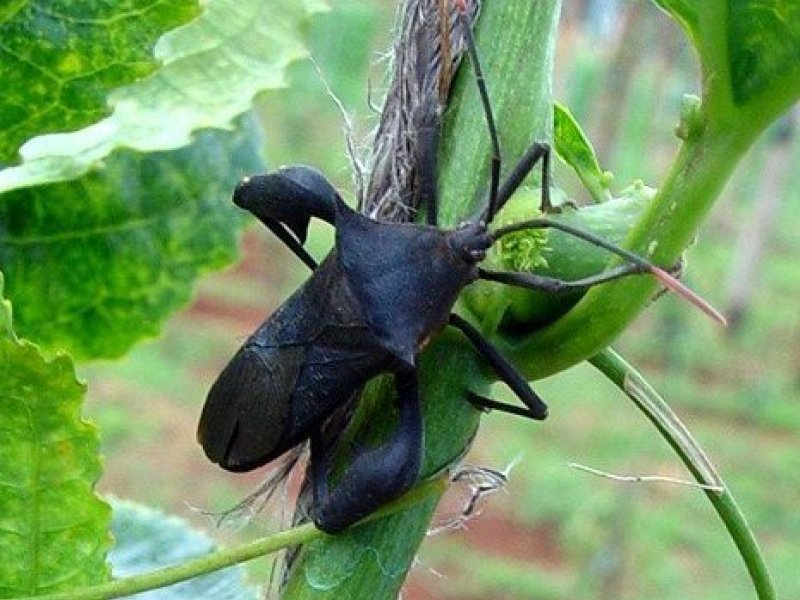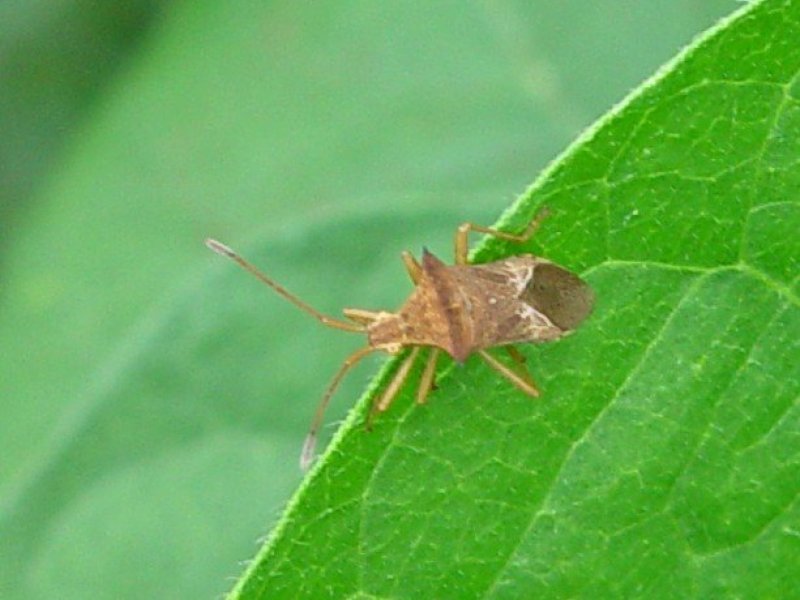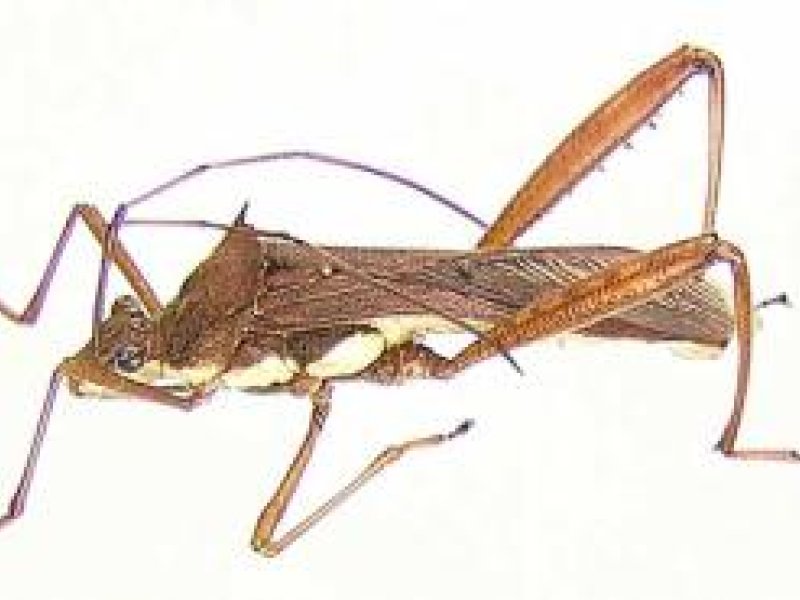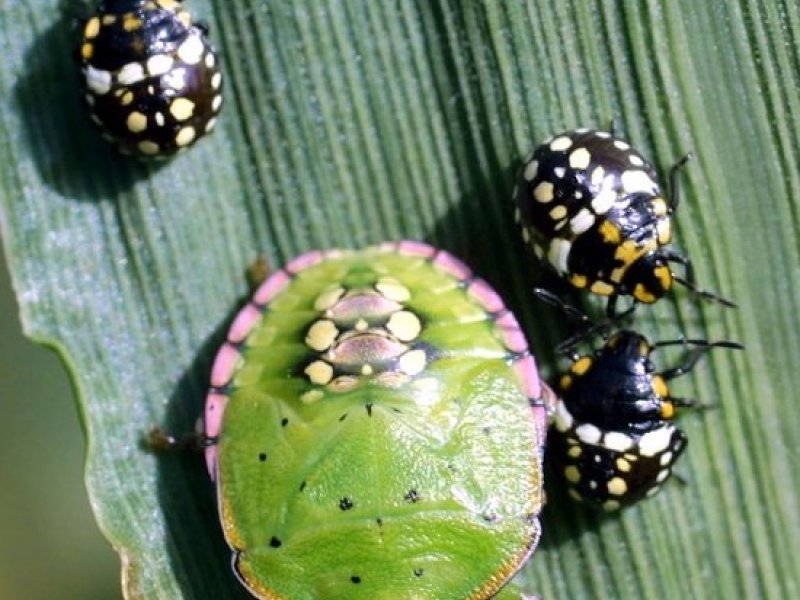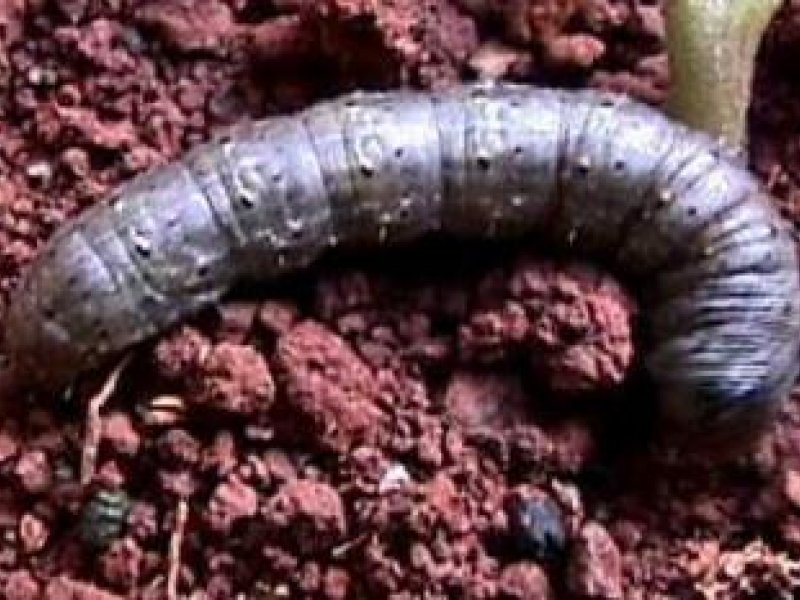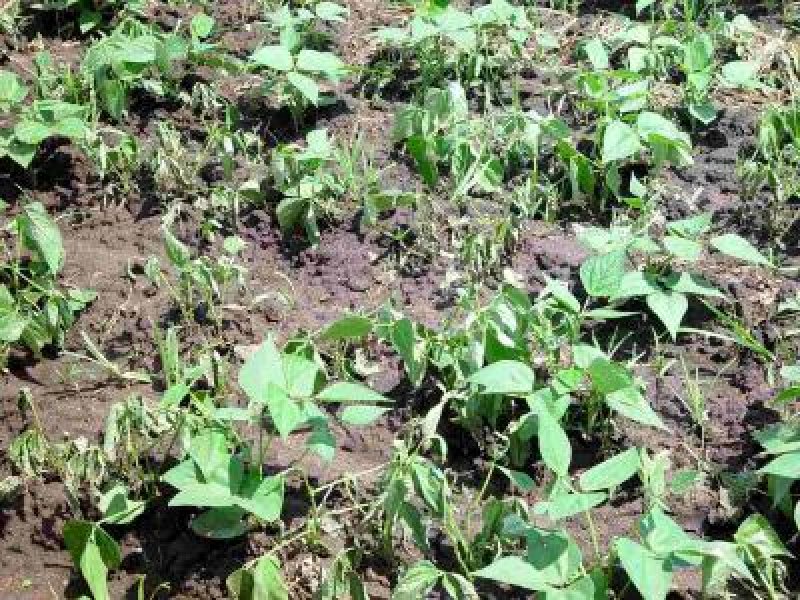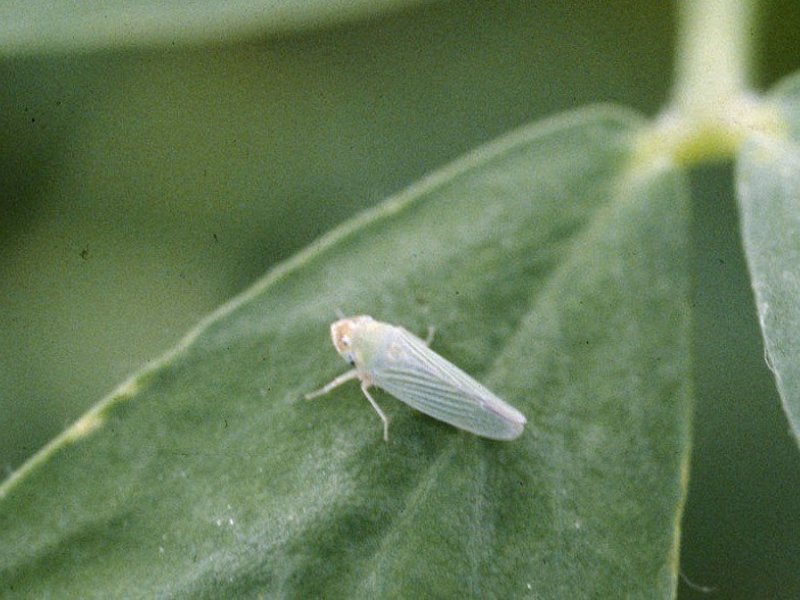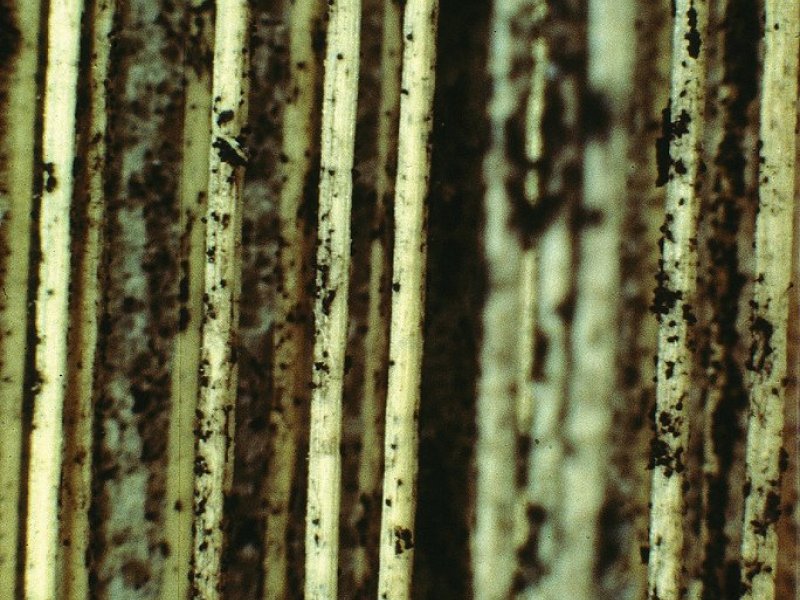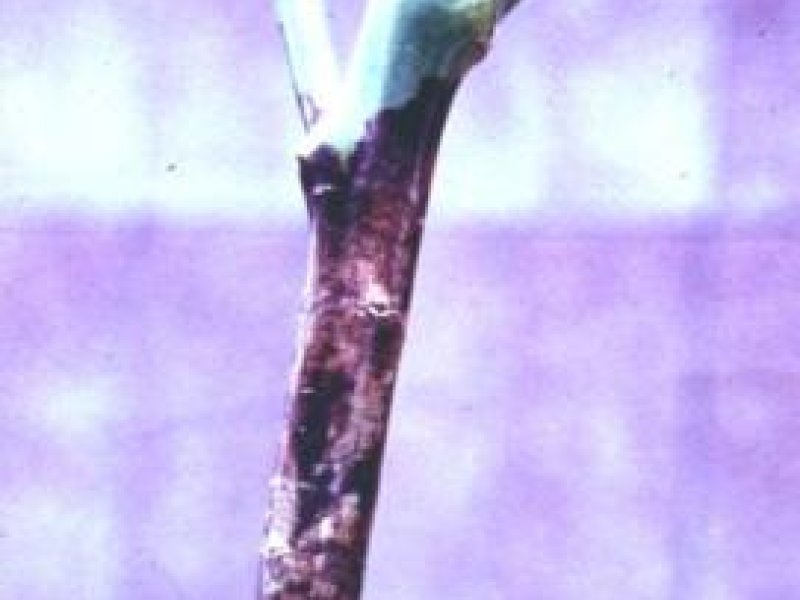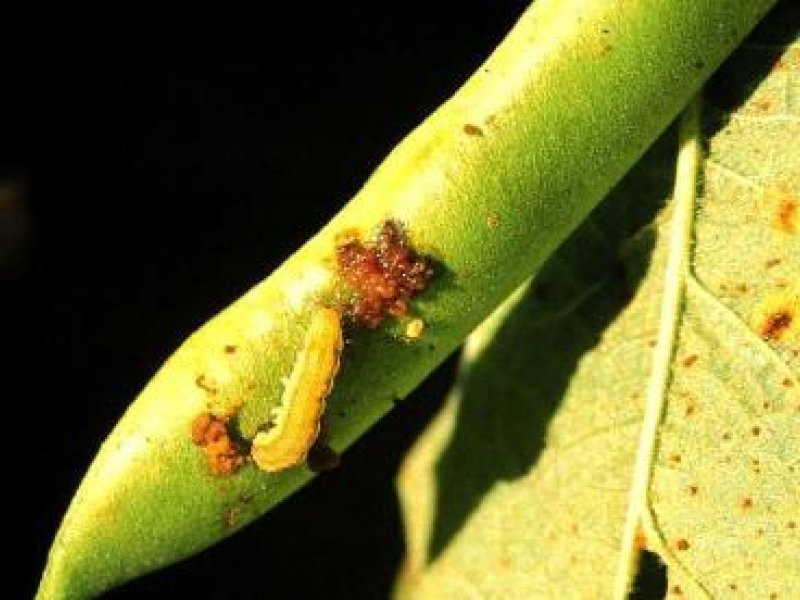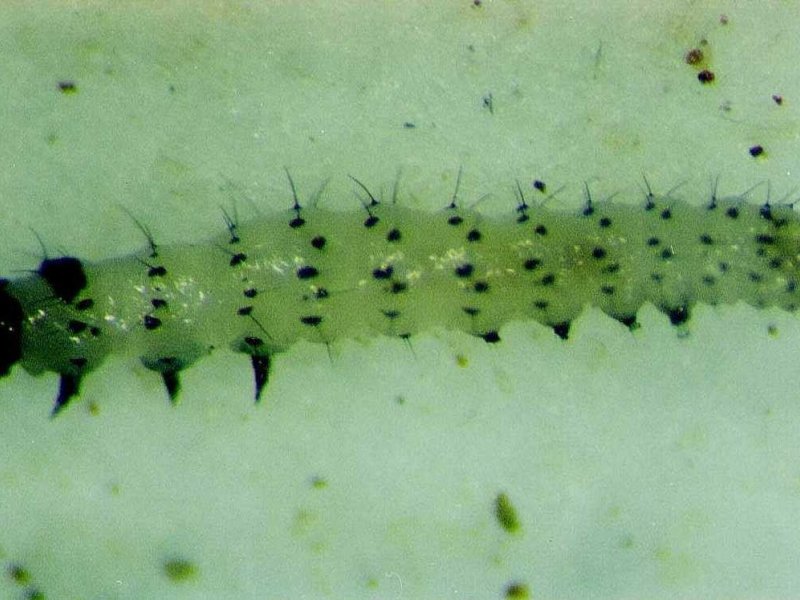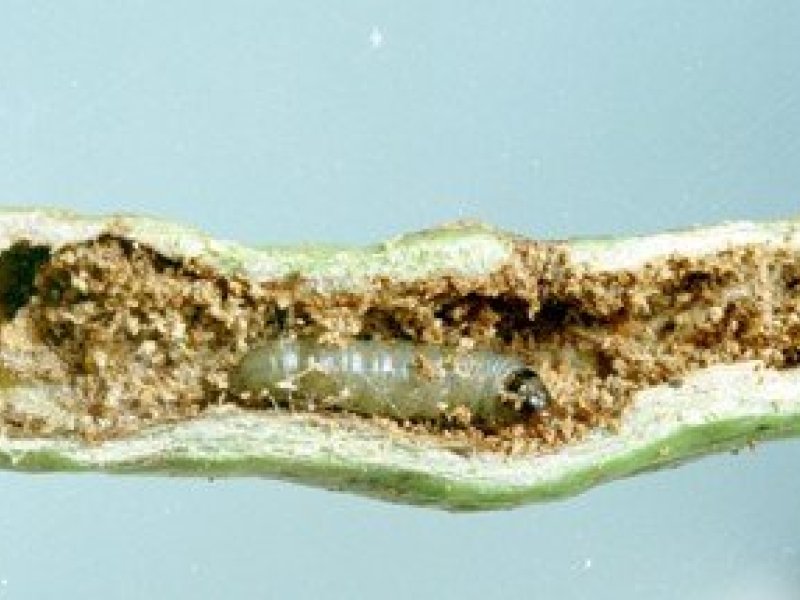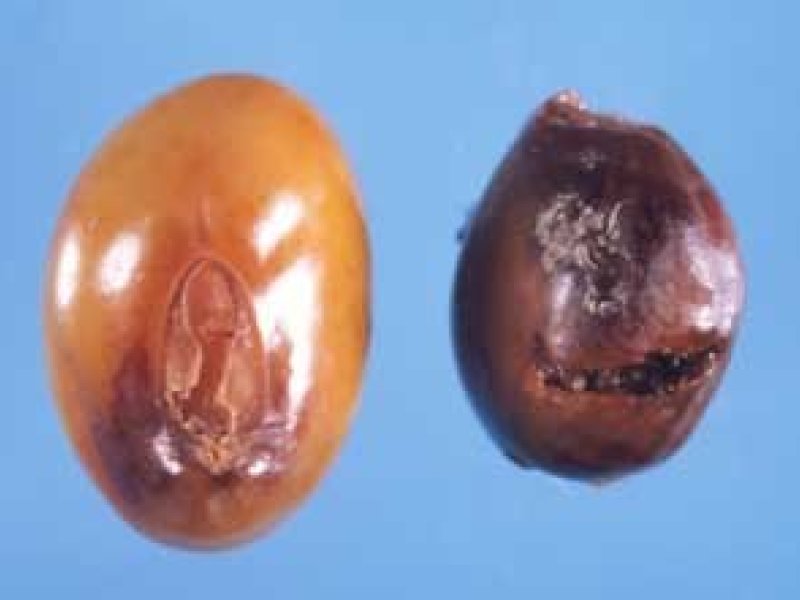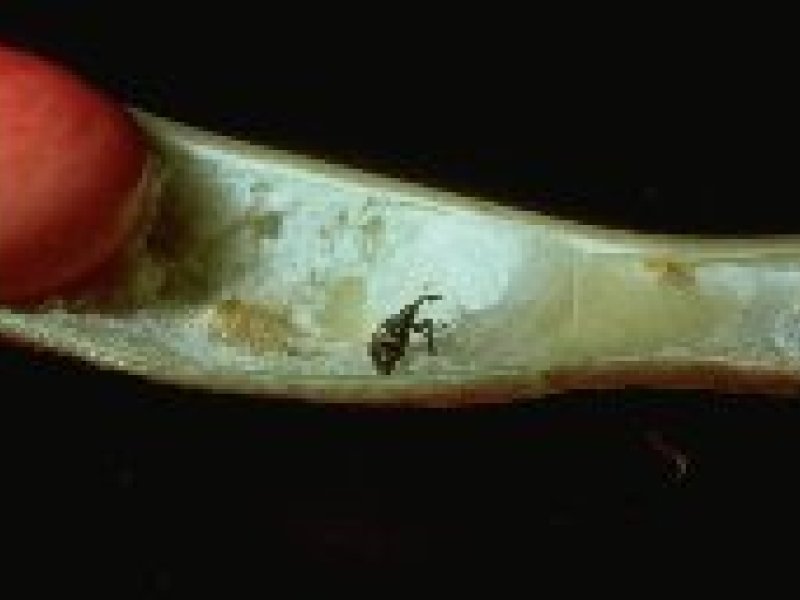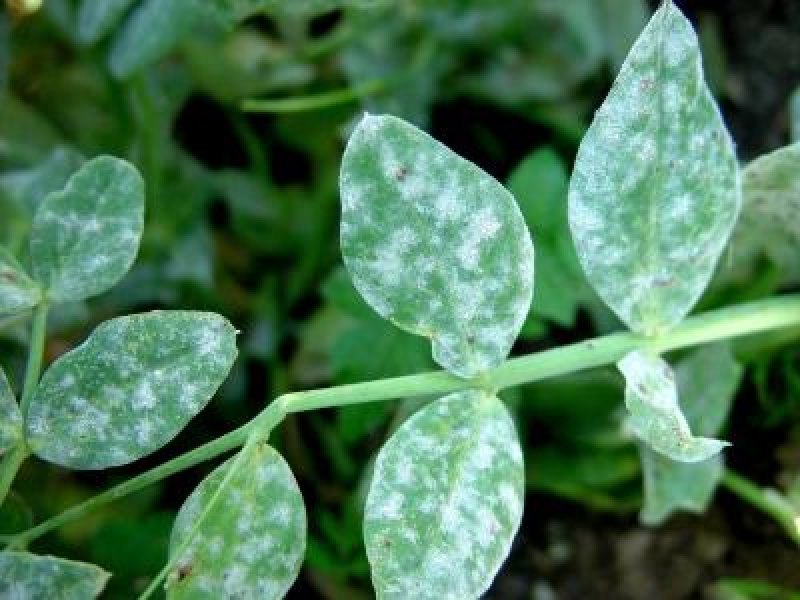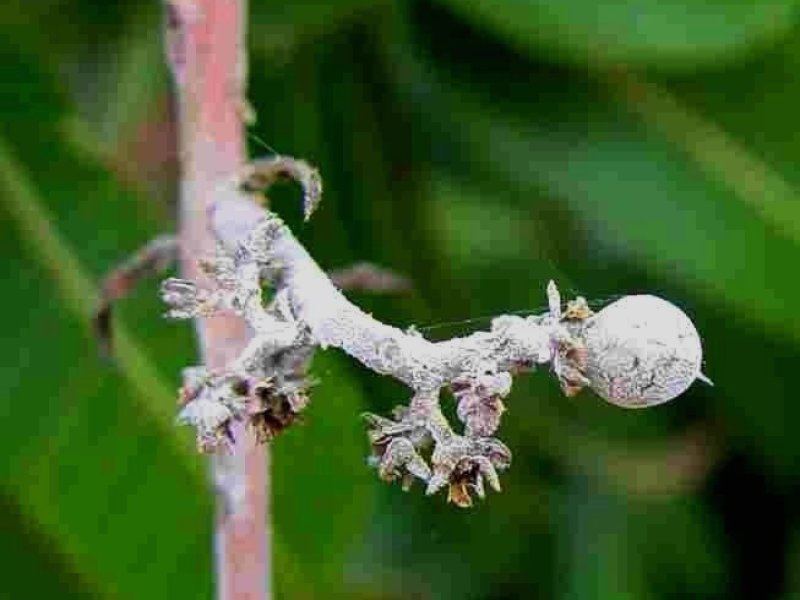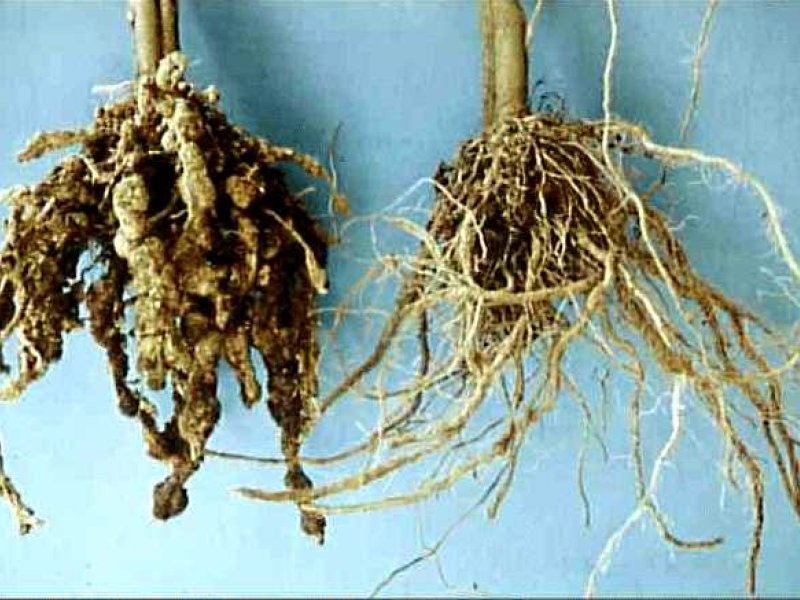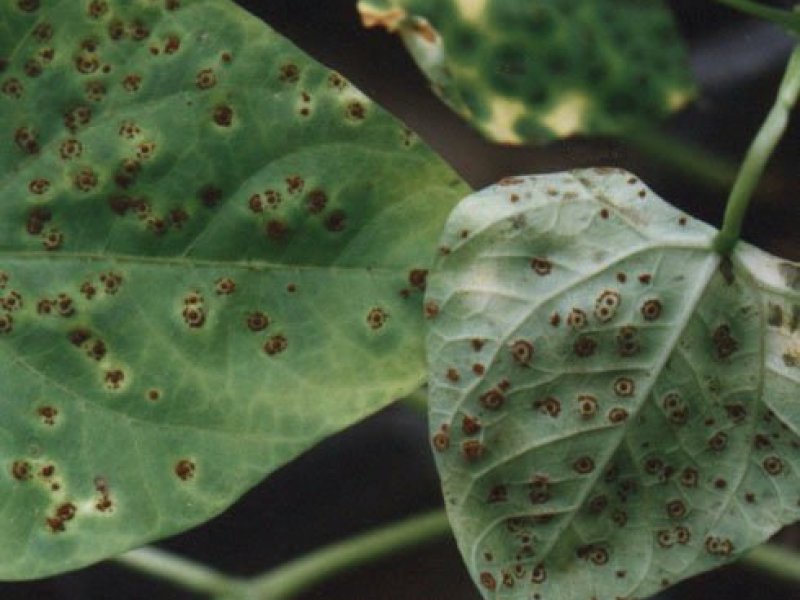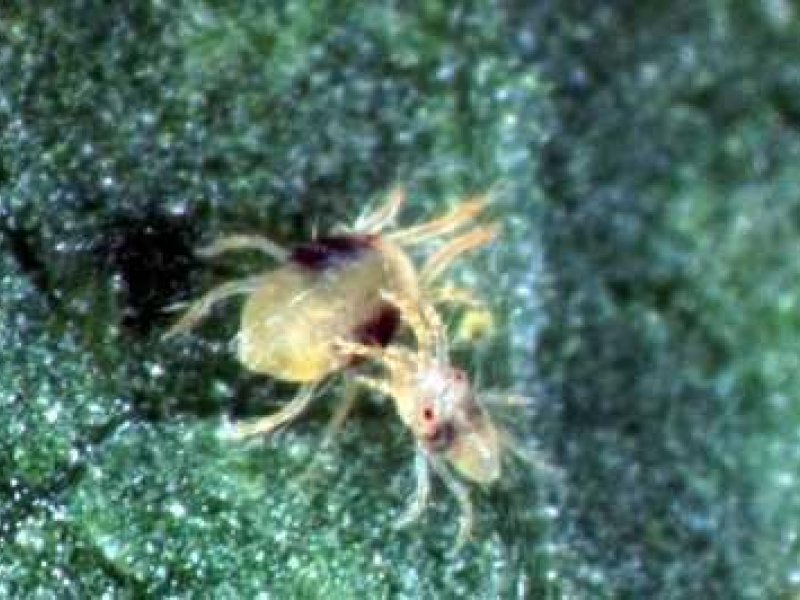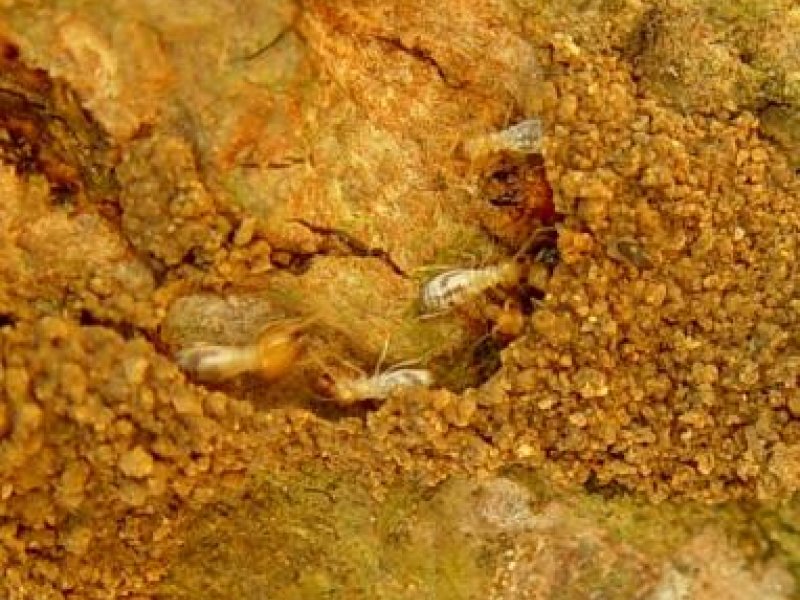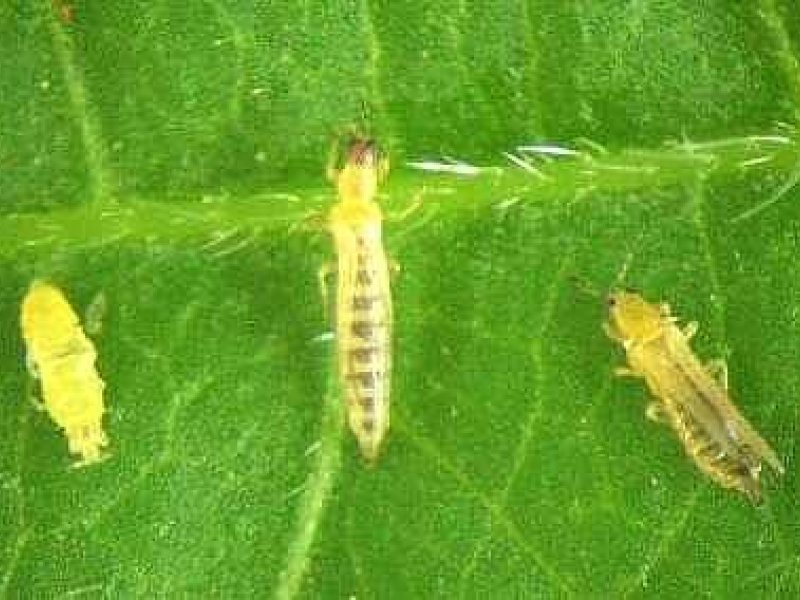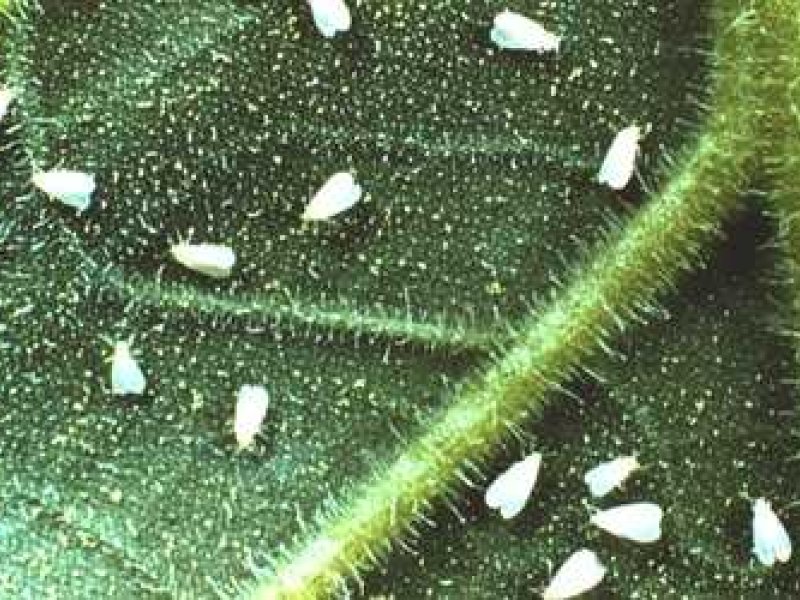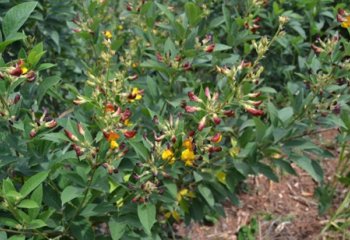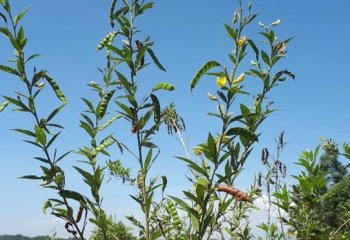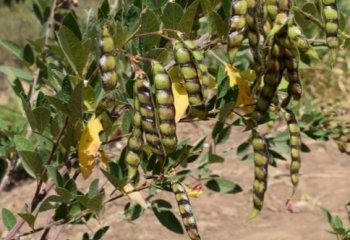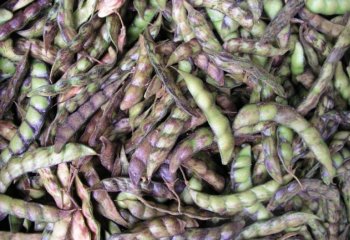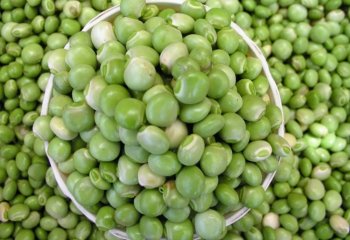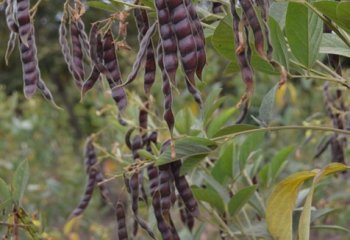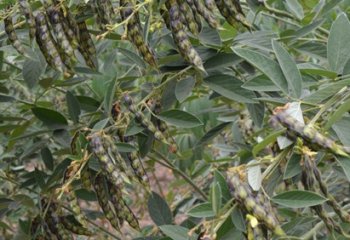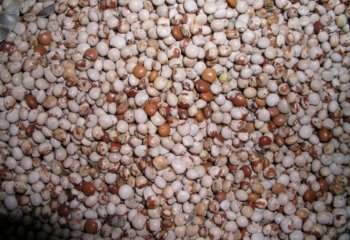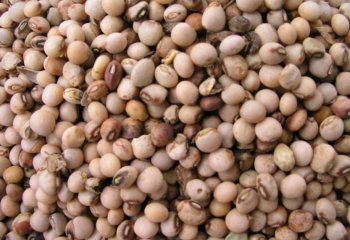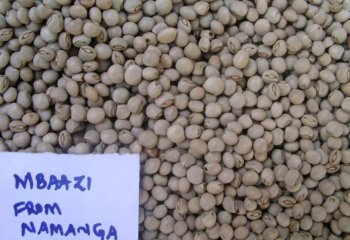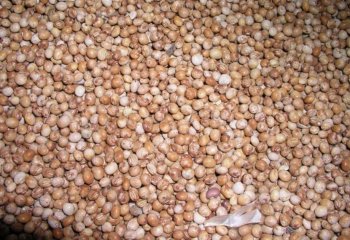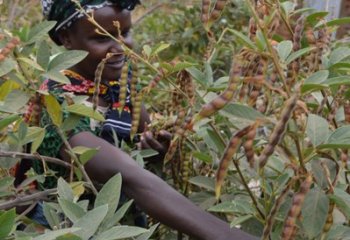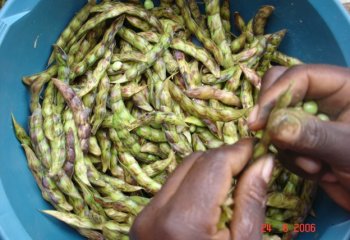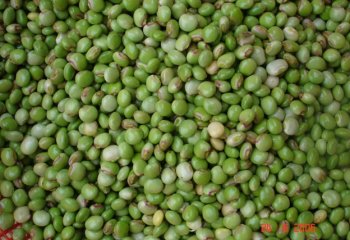|
Blister beetles (Coryna spp. and Mylabris spp.) Adults feed on the flowers and reduce the number of pods that are set. In location where pigeon pea is grown over large areas blister beetles cause little damage. However, in small pigeon pea plots that are in the flowering stage during the period of peak adult activity, most of the flowers may be eaten by the beetles and crop losses maybe substantial. The adults are medium to large sized beetles (2 to 5 cm in length), usually black and yellow or black and red in colour. The immature stages (larvae) do not feed on plants. They live in the soil and eat grasshopper eggs, and are therefore beneficial.
|
|
|
What to do:
|
|
Bugs Pod sucking bugs are primary pests of pigeon peas.
The most common pod-sucking bugs are: giant coreid bugs (Anoplocnemis spp), spiny brown bugs (Clavigralla spp), Riptortus bugs (Riptortus spp) and green stink bugs (Nezara viridula).
These bugs suck developing seeds through the pod wall. The seeds become shrivelled with dark patches. Attacked seeds do not germinate and are not acceptable as food. Fungal spores are sometimes transmitted with the mouthparts during feeding, resulting in rotting of the seeds. The spiny brown bug Clavigralla tomentosicollis is one of the most important pests of pigeon peas in Eastern Africa.
Sucking bug adults are difficult to control since they are very mobile and can invade crops from neighbouring sites.
|
|
|
What to do:
|
|
Cercospora leaf spot (Mycovellosiella cajani) Small circular necrotic spots (lesions) usually appear on older leaves. These spots join up causing leaf blight and leaf drop. The African isolates of the fungus produce concentric areas on the leaf spots. The disease causes severe losses when defoliation occurs before flowering and podding. The disease usually appears when plants are flowering and podding. The fungus is seed-borne. It is favoured by cool temperatures (25 degC) and humid rainy weather. The disease is more common in the long-duration and perennial varieties in Eastern Africa. |
|
|
What to do:
|
|
Cowpea seed beetle They are the most common and widespread insect pests in storage. Adults are 2-3.5 mm long. They attack both pods in the field and seeds in storage. They attack nearly mature and dried pods. Infested stored seeds can be recognised by the round exit holes and the white eggs on the seed surface. Post-harvest losses are highly variable, but losses can be over 90%. |
|
|
What to do:
|
|
Cutworms (Agrotis spp) Cutworms cut the stem of plants below the soil surface. The damaged plant wilts and withers. First instars are 0.7-1 cm, later instars are 3.5-5 cm long. |
|
|
What to do:
|
|
Fusarium wilt (Fusarium udum) It is a fungal disease. Symptoms include partial or total wilting of plants at flowering and podding, a purple band of stems extending from the base upwards, browning of the stem tissue in the purple band area, and browning or blackening of internal tissue when the main stem or primary branches are split. Infected young plants may not show the purple band symptom but have conspicuous internal browning and blackening. Affected fields show patches of dead plants. F. udum is seed and soil-borne. The fungus survives on infected crop debris in the soil for about 3 years.
Crop rotation is advisable against diseases such as Fusarium wilt. Pigeon pea is generally grown in inter- and mixed-cropping systems in rotation with other crops, particularly cereals. However, since the fungus-causing agent of wilt of pigeon pea survives on deep-seated roots of the host, the success of rotation will depend upon the field sanitation (removal of affected plants with their roots). A 4-5-year rotation has been found to free the field completely of the wilt pathogen (causing fungal agent). However, in smallholder scenarios this is not practical due to land restriction. One-year breaks with either sorghum or fallow reduced wilt in the following pigeon pea crop from more than 50 to below 20%. Pigeon pea rotation with tobacco has been recommended as a possible means of control because of the adverse effect of tobacco root exudates on the pathogen. For more information on Fusarium wilt click here.
|
|
|
What to do:
|
|
Leafhoppers or Jassids (Jacobiasca lybica) Jassids (leafhoppers) have been reported to cause damage to pigeon peas in Kenya. These small (2.5 mm) green and very mobile insects occur on the upper and lower leaf surface. The adults fly or hop away when disturbed. Nymphs resemble adults, but have no wings, and run sideways when disturbed. The eggs are inserted in the veins on the underside of leaflets. Adults and nymphs feed by sucking on the leaflets. Attacked leaves become cup shaped and yellow at the edges. Heavy attacks result in the leaflets turning red-brown, with subsequent defoliation and stunting. |
|
|
What to do:
|
|
Macrophomina stem canker (Macrophomina phaseolina) Initial symptoms on stems and branches are spindle-shaped spots with light grey centres surrounded by brown margins. The centres of the spots have scattered dots (pycnidial bodies - fungal spores). The spots may join up and cause the branches or whole plants to dry up and die. Diseased plants suddenly wilt. When diseased plants are uprooted their roots are rotten and shredded. The fungus mainly attacks secondary finer roots. These roots have dark, blackened streaks underneath their barks with dots (pycnidial bodies - fungal spores). The disease could be a serious problem in late-sown and in perennial or rationed pigeon peas. Disease development is favoured by hot dry weather (300C). Crops are more susceptible to the disease in the reproductive than in the vegetative stage. |
|
|
What to do:
|
|
Phytophthora blight (Phytophthora dreschsleri f.sp. cajani) The disease causes sudden death of seedlings. Infected leaves have water-soaked spots that turn brown to black. Infected leaves lose turgidity and finally become desiccated. On stems and leaf petioles the spots are slightly sunken. Affected stems or branches are girdled and foliage above dries up. Plants that are attacked but not killed often form large galls on their stems especially at the edges of spots. Thefungus does not infect the root system. The fungus is soil-borne and it also survives on infected crop debris. The disease is favoured by cool temperatures around 25 degC, cloudy humid weather and rain. Plants develop tolerance to the disease with age. |
|
|
What to do:
|
|
Pod borers The African bollworm (Helicoverpa armigera), the legume pod borer (Maruca vitrata = testulalis) the lima bean pod borer (Etiella zinckenella) are major pests of pigeon peas in East Africa. They feed on leaves, flowers and pods, destroying them.
The African bollworm (Helicoverpa armigera) Caterpillars are 1.5 to 4 cm long. They bore holes on pods and feed on the seeds. Usually developing in the pods and feeding partly mature seeds. For more information on the African bollworm click here.
The legume pod borer (Maruca vitrata) The adult of the legume pod borer is a moth with a wing span of 15-30 mm. It has light-brown forewings with white markings and pearly white hindwings. Though mainly nocturnal, the moth may also be seen during the day. They lay eggs in the flowers or buds, or on the pods. Caterpillars are whitish with black head and rows of conspicuous brown to black spots on the dorsal, lateral, and ventral surfaces of each body segment. Fully-grown caterpillars measure about 15mm in length. They pupate in the soil. Caterpillars web leaves, flower buds and pods and feed inside the web. Flowers usually show little sign of damage until they wilt and drop. They typically attack pods at the point of contact between two pods, or between a pod and a leaf or stem.
The lima bean pod borer Adults of the lima bean pod borer are brown moths with a wing span of about 20-25 mm. They lay eggs singly or in small groups on immature pods. Young caterpillars bore into the pod. They feed inside the pod reaching a length of 12 to 17 mm and are generally found in maturing and dried pods. Young caterpillars are green, turning red later. Faeces in the form of granules are found inside the damaging pods.
|
|
|
What to do:
|
|
Pod fly (Melanagromyza chalcosoma) It is a small black fly that lays eggs through the walls of developing pods. The maggots (white in colour and about 3 mm long) feed inside the green seed. The brown barrel shaped pupa is formed inside the pod but outside the seed.
There are no obvious external symptoms of attack till the fully-grown maggot chews holes in the pod walls leaving a window through which the flies emerge after pupation in the pod. Damaged seeds are of no value. The pod fly causes most damage on pigeon pea maturing during cool weather and pigeon pea planted at altitudes higher than 500 m above sea level.
|
|
|
What to do:
|
|
Pod weevil (Apion clavipes) It has been regarded as a major pest of pigeon pea in East Africa. Adults are small black weevils. The larvae are creamy white. Larvae damage the green seeds in pods but the damage is usually noticed only after adults emerge cutting the way out of the pod. The beetles also chew small holes in leaflets and flowers.
|
|
|
What to do:
|
|
Powdery mildew The disease can infect all aerial parts: leaves, flowers and pods. Characteristic of the disease is white greyish powdery fungal growth on affected plant parts. Small chlorotic spots develop on the upper surface of leaves and the corresponding lower surface develops white greyish powdery fungal growth. With time the powdery growth covers the entire lower leaf area. Severe infection causes heavy leaf drop. The fungus develops at temperatures ranging from 20 to 35°C , but 25°C is the optimum. The fungus survives on perennial pigeon peas and volunteer plants, and on the ratoon growth of the harvested plants. Plants with thicker leaves, as most varieties in Kenya are more tolerant to the disease than those with thin succulent leaves (Indian varieties). |
|
|
What to do:
|
|
Root-knot nematodes (Meloidogyne incognita, M. javanica) Affected plants are normally stunted and eventually wilt and die. The most characteristic symptom is formation of root galls (knots) and these can be seen with the naked eye. Affected roots rot.
|
|
|
What to do:
|
|
Rust (Uredo cajani) Symptoms appear as dark brown raised spots full of brown spores (uredia) on the lower leaf surfaces. Infected leaves dry and drop off. When disease is severe, it causes extensive defoliation. The disease is favoured by rain and wind that facilitate spore release, dispersal and development.
|
|
|
What to do:
|
|
Red spider mites (Tetranychus spp.) Red spider mites are about 0.6 mm long. They feed on the lower leaf surface causing white or yellowish spots on the upper leaf surface. Heavy infestation results in partial defoliation.
|
|
|
What to do:
|
|
Termites (Coptotermes formosanus) Termites can be a serious problem for coconut palms, particularly for young trees in tree nurseries or trees that have just been transplanted into the field. Termites live in the soil in hills, construct tunnel from the hills to the palms and feed on all parts of young coconut palms. Damage occurs mainly during the dry season.
Many plants have a repellent or even insecticidal effect on termites and can be applied as spray directly against termites or as barrier around the trunk of coconut palms:
|
|
|
What to do:
|
|
Thrips (Megalurothrips spp. and Frankliniella schultzei) Thrips are small (1.5 mm long), slender, brown insects with pale yellow hind wings that appear as a yellow line down the back of the body when the insect is at rest. Adult thrips have characteristic wings; the transparent wings have a fringe of hairs around the outside edge standing out in the same plane as the wing.
Several species of thrips are common on pigeon peas in Eastern Africa and are considered important pests. These thrips feed on leaves and flowers. Main damage is due to thrips feeding on flower buds and flowers. Heavy infestation can lead to shedding of buds and flowers. However, according to reports from India, pigeonpea plants produce more flowers than the plant can sustain, so many are lost naturally and it is difficult to assess thrips damage (Ikisan, 2000).
|
|
|
What to do:
|
|
Whiteflies (Bemisia tabaci, Trialeurodes vaporariorum and Aleyrodes proletella) Several species of whiteflies are found on cassava in Africa. Feeding causes direct damage, which may cause considerable reduction in root yield if prolonged feeding occurs. Some whiteflies cause major damage to cassava as vectors of cassava viruses. The spiralling whitefly (Aleurodicus dispersus) was reported as a new pest of cassava in West Africa in the early 90s. The adults and nymphs of this whitefly occur in large numbers on the lower surfaces of leaves covered with large amount of white waxy material. Females lay eggs on the lower leaf surface in spiral patterns (like fingerprints) of white material secreted by the female. This whitefly sucks sap from cassava leaves. It excretes large amounts of honeydew, which supports the growth of black sooty mould on the plant, causing premature fall of older leaves.
The tobacco whitefly (Bemisia tabaci) transmits the African cassava mosaic virus one of the most important factors limiting production in Africa. The adults and nymphs of the tobacco whitefly occur on the lower surface of young leaves. They are not covered with white material. The nymphs appear as pale yellow oval specks to the naked eye.
|
|
|
What to do:
|
Geographical Distribution in Africa
Geographical distribution of Pigeon Pea in Africa. Updated on 8th July 2019. Source FAOSTAT.
© OpenStreetMap contributors, © OpenMapTiles, GBIF. https://www.gbif.org/species/2960383
Read more
Angola: Ervilha de (Van der Maesen, L.J.G., 2006)
Benin: Adjayi Klwékoun (Fon, Goun), Blikodje (Sahouè), Otinini, Ofiri, Otili (Yoruba)
Burundi: Urucaruzo, Inkunde (Kirundi) (Baerts, M. & J. Lehmann., 1989)
Comoros: Mtsongi (Great Comoros), Pois D'angol (French) (Adjanohoun, E., et al., 1982).
DRC Congo: Wandu (Kongo), Pois-cajan, Ambrevade (fr.) (Latham and Mbuta., 2006)
Ethiopia: Yergib ater, Yewof ater (Amargna); Gitea (Haderigna); Farengota, Ohota (Konsogna); Ades (Nuyergna); Salboko‑ghed (Somalgna); Kafo atara, Kafwa ateriya (Wolayetgna) (Tesemma et al., 1993)
Gabon: Osangé-W'éréré, Osangé W'orungu (Mpongwè)
Kenya: Mbalazi (Fruit), Mubalazi (Chonyi); Njugu (Embu); Mbubalazi (Giriama); Nzuu (Kamba); Mbalazi (Fruit), Mubalazi (Kambe); Njugu (Kikuyu); Obong (Luo); Njugu (Marakwet); Nangu, Ncugu (Meru); Mbaazi (Swahili); Epana (Teso); Njugu (Tharaka) (P Maundu et al., 1999)
Madagascar: Ambarivatry, Ambatribe, Ambaty, Amberivatry, Ambote, Ambraty , Ambrevade, Ambrevate, Antsotry (Col- Plante)
Mozambique: Mundogi (Chindau) (Bruschi, P., 2011)
Nigeria: Otili (Yoruba) (Ashidi, J.S., 2010). Fiofio (Igbo) (Aiyeloja A.A & O.A Bello., 2006)
Tanzania: Lupelemende (Mwera); Mblazi (Nyam); Mshughuu (Pare); Mbaazi (Samb); Mbaazi (Swahili) (Mbuya et al., 2009).
Togo: Eklui (Adja), Pois D'angol (French) (V. Adjakidje et al., 1986)
Uganda: Mpinnamiti (Luganda); Kapenda (Luo); (Nkuuku) (Katende et al., 1995).
General Information and Agronomic Aspects
Introduction
Pigeon pea (Cajanus cajan) commonly known as pigeon pea is a perennial legume plant that belongs to the Fabaceae family and the Cajanus genus. The genus Cajanus encompasses a total of 34 species. Within Africa, two indigenous Cajanus species are recognized: Cajanus kerstingii Harms, found in West Africa, and Cajanus scarabaeoides (L.) Thouars, which is distributed along the coastlines of Africa and Madagascar, as well as in certain inland areas. Pigeon pea is an important grain legume crop of rain-fed agriculture in the semi-arid tropics.
© Maundu, 2006
Main pigeon pea producing regions are the Indian sub-continent, Central America and Southern and Eastern Africa. Pigeon pea is produced as a vegetable or export grain crop in southern and eastern Africa. In Kenya, pigeon pea is the third most widely grown pulse crop, and it is one of the fastest growing cash crops with an annual growth rate of 3% in the last decade. Green pigeon pea is being exported from Kenya to Europe (Snapp et al, 2003). The dry grain is also an important local pulse and export commodity in several African countries (Kenya, Malawi, Mozambique, Tanzania and Uganda) (Minja, et al, 1999).
Pigeon pea is a perennial shrub that is commonly grown as an annual crop. It has very slow initial development (up to 2 months after planting). With a deep taproot, pigeon peas are able to take up nutrients and water from lower subsoil layers. Therefore, in crop mixes they hardly compete with the companion crops. This crop grows and yields well under conditions of low rainfall and poor soil. Pigeon pea is well balanced nutritionally and an excellent source of protein. It is eaten as a vegetable (immature pods or green pea) or as dried grain (cooked and eaten as dhal, dry split cotyledons). The crop has many other uses: the wood is used as fuel, and the leaves and husks provide livestock feed.
© Maundu, 2021
Pigeon pea is useful as tall hedges on dry soil and on the bunds of paddy fields. The branches and stems can be used for baskets and firewood. It is often grown as a shade crop, cover crop or windbreak. After establishment, pigeon pea improves the soil by its extensive root system. The bacterium Rhizobium that lives on the roots of the pigeon pea is able to fix nitrogen and thus to improve soil fertility. Fallen leaves are used as mulch. Traditional uses as medicine are many, e.g. young leaves are applied to sores, herpes and itches.
India is one of the largest producers and consumers of pigeon pea. Other significant producers include Myanmar, Kenya, Malawi, and Tanzania. The demand for pigeon pea is driven by its nutritional value and versatility in cooking. In Africa, pigeon pea is an important crop, especially in regions with challenging environmental conditions such as drought and poor soil. It contributes to food security and provides an additional income source for many small-scale farmers. Countries in East and Southern Africa, such as Kenya, Tanzania, Malawi, and Uganda, are among the key producers of pigeon pea on the continent.
(Van der Maesen, L.J.G., 2006, Orwa C. et al., 2009, Plantvillage (n.d))
Species account
Cajans cajan is a short-lived perennial (1-5 years) shrub, usually grown as an annual. Depending on the variety and growing conditions, it can reach heights ranging from 1 to 4 m. Leaves: are trifoliate, composed of three leaflets that exhibit an ovate or lanceolate shape. These leaflets possess a smooth margin and a prominent midrib. Flowers: vibrant yellow hue, although there are cultivars that exhibit white or reddish petals, grouped in clusters at the terminal ends of branches. Each flower is endowed with five petals, with the uppermost petal often displaying slight variations in both size and color. Fruit: elongated straight or sickle-shaped pod, ranging in length from 3-10 cm, 4–9-seeded. Splits into 2 spiraling valves. Seeds: oval-shaped and come in a variety of colors, including green, yellow, brown, or speckled.
(Orwa C. et al., 2009, Van der Maesen, L.J.G., 2006, Hyde, M.A et al.,2023).
© Muia J 2022
© Muia J 2022
Ⓒ Adeka et al. 2006. Foods of the Nairobi people
Ⓒ Foods of the Nairobi people
Variation in Pigeon
Pigeon pea, exhibits significant variation in its characteristics such as growth habits (erect, semi-erect, or sprawling), leaf forms, flower colors (white, cream, yellow, red, and purple), and seed shape (round to oval) color (light beige to dark brown) and sizes.
This variation has been influenced by geographical distribution and local preferences. Deliberate breeding has further contributed to this diversity, leading to the development of cultivars tailored to specific climates and soils. Notably, some cultivars have been bred to mature in fewer months, catering to the needs of different regions. It’s important that farmers consult with local extension officers for suitable cultivars.
© Maundu, 2021
© Maundu, 2021
Pigeon pea varieties in Kenya and their characteristics:
| Variety | Maturity period (days) | Potential yield (90 kg bags/acre) | Characteristics |
| "Kat 60/8" | 135-150 | 5-7 for one season (13 for 2 seasons) | Grains are white with brown spots and smaller seed size than local races. Grows between 0-1800 m above sea level and performs well where temperatures are high. Tolerant to Fusarium wilt and leaf spot diseases. Susceptible to pod sucking bugs and pod borers. |
| "Kat 81/3/3" | 170-185 | 6-11 | Tolerant to wilt, pod sucking bugs and pod borers. Cream white grain with large brown patches. Adapted to medium and higher altitudes (over 900 m above sea level) |
| "Kat 777" | 160-180 | 6-10 | Oval white seeds. Adapted to medium and higher altitudes (above 900 m above sea level) |
| "ICPL 89091" | 120 | 4 for one season, 8 for 2 seasons | It is grown in the same range of altitude as "KAT 60/82" but is more adapted to the more humid coastal zones. Performs best in pure stands at quite high density. |
| "Mbaazi-1" | 105-120 | 4 in one season | Grows between 600 and 900 m above sea level. Grain greyish in colour. Should be grown as a pure stand |
| "Mbaazi-2" | 150-180 | 6 | Adapted to medium and high altitudes (900 - 1800 m). Grain greyish in colour. Tolerant to insect pests and Fusarium wilt |
| "Mbaazi-3" | 90-105 | 6 | Performs well at altitudes 10-1500 m. Grain greyish in colour |
| "Local races" |
Examples of pigeon pea varieties in Tanzania
- "Komboa" (performs well below altitude of 1500 m; early maturing about 90 - 100 days; grain mottled cream and brown; potential yield of about 4 t/ha)
- "Mali" (adapted to altitude between 500 - 1500 m; medium maturity: 130 - 150 days; grain yield 1.0 - 3.0 t/ha; resistant to Fusarium wilt; tolerant to insect pests and drought)
- "Tumia" (performs well below 1500 m altitude; recommended for areas with low to medium rainfall (250 - 600 mm); maturity less than 150 days; grain yield of 1.8 - 2.4 t/ha; white grain colour; susceptible to Fusarium wilt; tolerant to drought)
- "Luwe 1 - 5" (maturity of about 159 days; grain yield of 1.2 t/ha; white grain colour; susceptible to Fusarium wilt)
- "KAT 60/8" (as in Kenya)
Examples of pigeon pea varieties in Uganda
- "KAT 60/8" (as in Kenya)
- "Apio Elina" (local variety; grown between 1000 - 1175 m; maturity: 6 - 9 months; grain yield: 250 - 500 kg/ha)
- "Adyang" (local variety; maturity: 6 - 9 months; yield: 250 - 450 kg/ha)
- "ICPL 87091" (maturity: 97 - 104 days; gain yield: 1.99 t/ha; white grain colour)
- "ICPL 87101" (maturity: 93 - 102 days; grain yield: 2.2 t/ha; brown grain colour)
- "ICPL 90029" (maturity: 92 - 104 days; grain yield: 1.6 - 2.5 t/ha; brown grain colour)
Propagation is by seed, stem cuttings rarely succeed. Pigeon pea varieties differ not only in form of seeds, colour and taste, but also in growth habit, time of flowering and susceptibility towards pests and diseases. Seed rate: 20-25 kg per ha (8-10 kg per acre).
Ecological conditions
Optimum temperatures for pigeon pea cultivation range from 18 to 38°C. Pigeon pea does not tolerate frost. Above 29°C, soil moisture and fertility need to be adequate. Rainfall optimum is 600-1000 mm/year. Pigeon pea is a short day plant. Flowering is triggered by short days, whilst with long days plants grow vegetative. It is sensitive to high salinity and to water logging. It flowers well where rainfall is 1500 to 2000 mm. On deep, well-structured soil it will grow where rainfall is 250 to 370 mm. Pigeon pea is rarely found above altitudes of 2000 m. Drained soils of reasonable water-holding capacity and with pH 5-7 are favourable for its growth. Pigeon pea does not tolerate shallow soils or water logging.
Agronomic aspects
Land preparation
Pigeon pea thrives best in seedbeds prepared by deep ploughing and cultivations to reduce weeds. Seeds should be sown in rows with spacing of 30-50 cm x 75-150 cm and 10 cm deep. There is no standard spacing - spacing depends on variety, soil type and production system. In dry areas, and especially in coarse-textured, infertile soils, farmers use wide spacing between plants to limit competition.
Plants are fairly slow to start and weed control for the first two months is important in crop establishment. Once plants are established they grow vigorously.
Husbandry
Weeds must be controlled to facilitate slow initial growth. Wind may bend the plants but staking is not practised. Response to fertilisers is seldom economic. In Eastern Africa, the crop is cultivated on marginal lands by resource-poor farmers, who traditionally grow landraces. Inputs such as fertilisers, irrigation and pesticides are hardly used.
Intercropping
In intercropping, the crop performs well with 2 rows of cereals (e.g. sorghum, millets), cotton or groundnut. After harvest of the intercrop, long-duration pigeon pea continues to grow and protects the soil. Pigeon pea is regarded as a good plant for restoration of fertility and is used in a rotation with crops such as maize-groundnut-tobacco-pigeon pea for three to four years in Uganda. One of the advantages of pigeon pea is the increased growth of the grass interplanted with it. In Uganda, it is usually sown in alternate rows with sesame or African finger millet (Eleusine coracana), and in Malawi with maize. In Tanzania, the main intercrop is cassava. In Kenya, sorghum and maize are the most common intercrops with pigeon pea. However, due to its high demand, there is a tendency to move away from traditional intercropping to monocropping. In Ukambani and Coastal strip, Kenya, the crop is grown commercially in large plots.
Harvest, post-harvest practices and markets
Harvest
The crop is usually cut near the ground when most pods are mature, or mature pods are picked individually. Green pods are picked over a long period in home gardens or hedge crops. Ratoon cropping is mostly practiced in pigeon pea producing areas in Kenya. After harvest the stems are cut back to facilitate re-growth and a second crop is harvested in the subsequent season.
Post-harvest practices
Entire air-dried plants or pods are threshed, usually by hand or with cattle, and seed is cleaned. Clean bins prevent insect attack, which can be considerable. Storage as split peas reduces bruchid attacks. Processing includes dhal making, either wet (after sprinkling heaps of seed) or dry, by milling.
Markets
Main pigeon pea producing regions are the Indian sub-continent, Central America and Southern and Eastern Africa. Pigeon pea is produced as a vegetable or export grain crop in southern and eastern Africa. In Kenya, pigeon pea is the third most widely grown pulse crop, and it is one of the fastest growing cash crops with an annual growth rate of 3% in the last decade. Green pigeon pea is being exported from Kenya to Europe (Snapp et al., 2003). The dry grain is also an important local pulse and export commodity in several African countries (Kenya, Malawi, Mozambique, Tanzania and Uganda) (Minja, et al., 1999).
Nutritional value and recipes
Pigeon pea is a nutritious legume that offers a range of health benefits. Pigeon peas are a good source of plant-based protein, making them a valuable component of vegetarian and vegan diets. They provide a substantial amount of amino acids, the building blocks of protein, aiding in muscle growth and repair.
Furthermore, pigeon peas are a good source of dietary fiber, which supports digestive health by promoting regular bowel movements and preventing constipation. The fiber content also helps regulate blood sugar levels, contributing to better glycemic control. This can be particularly beneficial for individuals with diabetes.
Additionally, pigeon peas contain a notable amount of vitamins and minerals. They are a good source of B-vitamins such as folate (vitamin B9), which is crucial for DNA synthesis and cell division, making it especially important for pregnant women. The legume also provides minerals like iron, potassium, and magnesium. Iron is essential for oxygen transport in the body, while potassium and magnesium play roles in maintaining proper heart function and nerve signaling. Pigeon peas are low in saturated fat and cholesterol, making them heart-healthy. Incorporating them into the diet can contribute to reducing the risk of cardiovascular diseases. (van der Maesen, L.J.G., 2006.
Further reading:
• https://www.1mg.com/articles/pigeon-pea-arhar-6-amazing-health-benefits-it-offers/
• https://www.boldsky.com/health/nutrition/2018/health-benefits-of-pigeon-peas-126903.html
Table 1: Proximate composition of 100g edible portion.
Code Food Name |
Pigeon peas, dry, unsoaked, boiled, drained (without salt) |
Pigeon peas, dry, unsoaked, boiled (without salt, water not discarded) |
Pigeon peas, dry, water-soaked, boiled in different water, drained (without salt) |
Recommended daily allowance (approx.) for adults a |
Edible conversion factor |
1 |
1 |
1 |
|
Energy (kJ) |
553 |
398 |
553 |
9623 |
Energy (kcal) |
132 |
95 |
132 |
2300 |
Water (g) |
61.8 |
72.5 |
61.8 |
2000-3000c |
Protein (g) |
9.1 |
6.5 |
9.1 |
50 |
Fat (g) |
0.9 |
0.7 |
0.9 |
<30 (male), <20 (female)b |
Carbohydrate available (g) |
16.9 |
12.1 |
16.9 |
225 -325g |
Fibre (g) |
9.6 |
6.9 |
9.6 |
30d |
Ash (g) |
1.7 |
1.2 |
1.7 |
|
Minerals |
||||
Ca (mg) |
172 |
65 |
56 |
800 |
Fe (mg) |
5.4 |
2 |
1.7 |
14 |
Mg (mg) |
128 |
48 |
41 |
300 |
P (mg) |
272 |
106 |
85 |
800 |
K (mg) |
1200 |
391 |
375 |
4,700f |
Na (mg) |
21 |
8 |
8 |
<2300e |
Zn (mg) |
2.9 |
1.13 |
0.91 |
15 |
Se (mcg) |
15 |
7 |
5 |
30 |
Bioctive compounds. |
||||
Vit A RAE (mcg) |
19 |
8 |
6 |
800 |
Vit A RE (mcg) |
38 |
17 |
12 |
800 |
Retinol (mcg) |
0 |
0 |
0 |
1000 |
b-carotene equivalent (mcg) |
230 |
100 |
72 |
600 – 1500g |
Thiamin (mg) |
0.72 |
0.2 |
0.18 |
1.4 |
Riboflavin (mg) |
0.14 |
0.05 |
0.04 |
1.6 |
Niacin (mg) |
2.34 |
0.7 |
0.6 |
18 |
Dietary Folate Eq. (mcg) |
340 |
74 |
64 |
400f |
Food folate (mcg) |
340 |
74 |
64 |
400f |
Vit B12 (mg) |
0 |
0 |
0 |
3 |
Vit C (mg) |
1.5 |
0 |
0 |
60 |
Source (Nutrient data): FAO/Government of Kenya. 2018. Kenya Food Composition Tables. Nairobi, 254 pp. http://www.fao.org/3/I9120EN/i9120en.pdf
RE=retinol equivalents.
RAE =Retinol activity equivalents. A RAE is defined as 1μg all-trans-retinol, 12μg beta-carotene, or 24μg α-carotene or β-cryptoxanthin.
$ Draining the water several times leaches away water soluble nutrients significantly.
a Lewis, J. 2019. Codex nutrient reference values. Rome. FAO and WHO
b NHS (refers to saturated fat)
c https://www.hsph.harvard.edu/nutritionsource/water/
d British Heart Foundation
e FDA
f NIH
g Mayo Clinic
Nutritive Value per 100 g of edible Portion
| Raw or Cooked Pigeon Pea | Food Energy (Calories / %Daily Value*) |
Carbohydrates (g / %DV) |
Fat (g / %DV) |
Protein (g / %DV) |
Calcium (g / %DV) |
Phosphorus (mg / %DV) |
Iron (mg / %DV) |
Potassium (mg / %DV) |
Vitamin A (I.U) |
Vitamin C (I.U) |
Vitamin B 6 (I.U) |
Vitamin B 12 (I.U) |
Thiamine (mg / %DV) |
Riboflavin (mg / %DV) |
Ash (g / %DV) |
| Pigeon Peas (Red Gram) cooked | 121 / 6% | 23.2 / 8% | 0.4 / 1% | 6.8 / 14% | 43.0 / 4% | 119.0 / 12% | 1.1 / 6% | 384 / 11% | 3.0 IU / 0% | 0.0 / 0% | 0.1 / 3% | 0.0 / 0% | 0.1 / 10% | 0.0 / 0% | 1.1 |
| Pigeon Peas (Red Gram) raw | 343 / 17% | 62.8 / 21% | 1.5 / 2% | 21.7 / 43% | 130 / 13% | 367 / 37% | 5.2 / 29% | 1392 / 40% | 28.0 IU / 1% | 0.0 / 0% | 0.3 / 14% | 0.0 / 0% | 0.6 / 43% | 0.2 / 11% | 3.5 |
*Percent Daily Values (DV) are based on a 2000 calorie diet. Your daily values may be higher or lower, depending on your calorie needs.
Recipes
1. Kitalolo (Green banana with vegetables) (Tanzania)
Ingredients
30 green banana (Mlali)
1 kg mbaazi (pigeon peas)
Handful cowpea leaves
1 tbs soda
2 lts sour milk
Procedure
Boil small beans with water until half cooked in a clay pot
Peel banana, cut into cubes, add into the clay pot
Sort, cut into small pieces the cowpea leaves and add into the mixture with soda and water, keep boiling until soft.
Remove the pot from heat and mash thoroughly
Add sour milk, stir until soft and liquid like porridge, serve.
Variations
Add butter or animal fat
Use pigeon pea instead of small beans
If served and remain left over for the nest day, add milk and stir well.
Serve.
Consumed by women and children only and not men
For sick people
Nutritive value
Carbohydrates
Protein
Minerals – sodium, calcium e.t.c
Vitamins – A, B - Complex e.t.c.
Water
2. Makukuru/Ngararimo (mashed maize with peas)
Ingredients
4 kg maize
2 kg beans (nganana/ pigeon pea)
2tbs soda
Water
Procedure
Boil the maize with soda and water in a clay pot until soft
Add beans into the pot to boil until done
Remove the pot, mash to make semi hard. Serve
Variation
Add salt to the taste
Add cooking oil or fat to add palatability
Serve
Serve without mashing
Serve with stew or sour milk
Serve as main dish
Serve as a packing lunch
Nutritive value
Carbohydrates
Protein
Minerals e.g. Sodium
Vitamins e.g. B-Complex
3. Ngunza kutu ((Kamba, Kitui, Kenya)
Ingredients
Pigeon peas (dry)
Pearl millet or maize flour
Method
Boil nzuu (pigeon peas) till well cooked
Fry the nzuu
Add water to boil
Add maize flour or mwee flour and cook to ugali
Serve alone
Eaten by all
Information on Pests
General information
The most important pests of pigeon peas are insects feeding on pigeon pea pods and seeds. Surveys in Kenya, Malawi, Tanzania and Uganda (Minja et al., 1999) have shown that the most important pests of pigeon pea pods and seeds in the region are:
- pod sucking bugs,
- pod and seed boring caterpillars,
- pod flies
Varieties that mature during the dry season have low damage levels (Snapp et al., 2003). A number of caterpillars (e.g. hairy caterpillars and semiloopers), and beetles (e.g. weevils, and foliage beetles) that feed on foliage of other legumes and grain legumes also attack pigeon peas, but they are usually not important.
Examples of Pigeon Pea Pests and Organic Control Methods
| Leafhoppers or Jassids (Jacobiasca lybica) Jassids (leafhoppers) have been reported to cause damage to pigeon peas in Kenya. These small (2.5 mm) green and very mobile insects occur on the upper and lower leaf surface. The adults fly or hop away when disturbed. Nymphs resemble adults, but have no wings, and run sideways when disturbed. The eggs are inserted in the veins on the underside of leaflets. Adults and nymphs feed by sucking on the leaflets. Attacked leaves become cup shaped and yellow at the edges. Heavy attacks result in the leaflets turning red-brown, with subsequent defoliation and stunting. What to do:
|
| They are the most common and widespread insect pests in storage. Adults are 2-3.5 mm long. They attack both pods in the field and seeds in storage. They attack nearly mature and dried pods. Infested stored seeds can be recognised by the round exit holes and the white eggs on the seed surface. Post-harvest losses are highly variable, but losses can be over 90%. What to do:
|
| Root-knot nematodes (Meloidogyne incognita, M. javanica) Affected plants are normally stunted and eventually wilt and die. The most characteristic symptom is formation of root galls (knots) and these can be seen with the naked eye. Affected roots rot.
What to do:
|
| Red spider mites (Tetranychus spp.) Red spider mites are about 0.6 mm long. They feed on the lower leaf surface causing white or yellowish spots on the upper leaf surface. Heavy infestation results in partial defoliation.
What to do:
|
| Thrips (Megalurothrips spp. and Frankliniella schultzei) Thrips are small (1.5 mm long), slender, brown insects with pale yellow hind wings that appear as a yellow line down the back of the body when the insect is at rest. Adult thrips have characteristic wings; the transparent wings have a fringe of hairs around the outside edge standing out in the same plane as the wing.
Several species of thrips are common on pigeon peas in Eastern Africa and are considered important pests. These thrips feed on leaves and flowers. Main damage is due to thrips feeding on flower buds and flowers. Heavy infestation can lead to shedding of buds and flowers. However, according to reports from India, pigeonpea plants produce more flowers than the plant can sustain, so many are lost naturally and it is difficult to assess thrips damage (Ikisan, 2000).
What to do:
|
| Pod sucking bugs are primary pests of pigeon peas.
The most common pod-sucking bugs are: giant coreid bugs (Anoplocnemis spp), spiny brown bugs (Clavigralla spp), Riptortus bugs (Riptortus spp) and green stink bugs (Nezara viridula).
These bugs suck developing seeds through the pod wall. The seeds become shrivelled with dark patches. Attacked seeds do not germinate and are not acceptable as food. Fungal spores are sometimes transmitted with the mouthparts during feeding, resulting in rotting of the seeds. The spiny brown bug Clavigralla tomentosicollis is one of the most important pests of pigeon peas in Eastern Africa.
Sucking bug adults are difficult to control since they are very mobile and can invade crops from neighbouring sites.
What to do:
|
| The African bollworm (Helicoverpa armigera), the legume pod borer (Maruca vitrata = testulalis) the lima bean pod borer (Etiella zinckenella) are major pests of pigeon peas in East Africa. They feed on leaves, flowers and pods, destroying them.
The African bollworm (Helicoverpa armigera) Caterpillars are 1.5 to 4 cm long. They bore holes on pods and feed on the seeds. Usually developing in the pods and feeding partly mature seeds. For more information on the African bollworm click here.
The legume pod borer (Maruca vitrata) The adult of the legume pod borer is a moth with a wing span of 15-30 mm. It has light-brown forewings with white markings and pearly white hindwings. Though mainly nocturnal, the moth may also be seen during the day. They lay eggs in the flowers or buds, or on the pods. Caterpillars are whitish with black head and rows of conspicuous brown to black spots on the dorsal, lateral, and ventral surfaces of each body segment. Fully-grown caterpillars measure about 15mm in length. They pupate in the soil. Caterpillars web leaves, flower buds and pods and feed inside the web. Flowers usually show little sign of damage until they wilt and drop. They typically attack pods at the point of contact between two pods, or between a pod and a leaf or stem.
The lima bean pod borer Adults of the lima bean pod borer are brown moths with a wing span of about 20-25 mm. They lay eggs singly or in small groups on immature pods. Young caterpillars bore into the pod. They feed inside the pod reaching a length of 12 to 17 mm and are generally found in maturing and dried pods. Young caterpillars are green, turning red later. Faeces in the form of granules are found inside the damaging pods.
What to do:
|
| Pod fly (Melanagromyza chalcosoma) It is a small black fly that lays eggs through the walls of developing pods. The maggots (white in colour and about 3 mm long) feed inside the green seed. The brown barrel shaped pupa is formed inside the pod but outside the seed.
There are no obvious external symptoms of attack till the fully-grown maggot chews holes in the pod walls leaving a window through which the flies emerge after pupation in the pod. Damaged seeds are of no value. The pod fly causes most damage on pigeon pea maturing during cool weather and pigeon pea planted at altitudes higher than 500 m above sea level.
What to do:
|
| It has been regarded as a major pest of pigeon pea in East Africa. Adults are small black weevils. The larvae are creamy white. Larvae damage the green seeds in pods but the damage is usually noticed only after adults emerge cutting the way out of the pod. The beetles also chew small holes in leaflets and flowers.
What to do:
|
| Blister beetles (Coryna spp. and Mylabris spp.) Adults feed on the flowers and reduce the number of pods that are set. In location where pigeon pea is grown over large areas blister beetles cause little damage. However, in small pigeon pea plots that are in the flowering stage during the period of peak adult activity, most of the flowers may be eaten by the beetles and crop losses maybe substantial. The adults are medium to large sized beetles (2 to 5 cm in length), usually black and yellow or black and red in colour. The immature stages (larvae) do not feed on plants. They live in the soil and eat grasshopper eggs, and are therefore beneficial.
What to do:
|
| Whiteflies (Bemisia tabaci, Trialeurodes vaporariorum and Aleyrodes proletella) Several species of whiteflies are found on cassava in Africa. Feeding causes direct damage, which may cause considerable reduction in root yield if prolonged feeding occurs. Some whiteflies cause major damage to cassava as vectors of cassava viruses. The spiralling whitefly (Aleurodicus dispersus) was reported as a new pest of cassava in West Africa in the early 90s. The adults and nymphs of this whitefly occur in large numbers on the lower surfaces of leaves covered with large amount of white waxy material. Females lay eggs on the lower leaf surface in spiral patterns (like fingerprints) of white material secreted by the female. This whitefly sucks sap from cassava leaves. It excretes large amounts of honeydew, which supports the growth of black sooty mould on the plant, causing premature fall of older leaves.
The tobacco whitefly (Bemisia tabaci) transmits the African cassava mosaic virus one of the most important factors limiting production in Africa. The adults and nymphs of the tobacco whitefly occur on the lower surface of young leaves. They are not covered with white material. The nymphs appear as pale yellow oval specks to the naked eye.
What to do:
|
| Termites (Coptotermes formosanus) Termites can be a serious problem for coconut palms, particularly for young trees in tree nurseries or trees that have just been transplanted into the field. Termites live in the soil in hills, construct tunnel from the hills to the palms and feed on all parts of young coconut palms. Damage occurs mainly during the dry season.
Many plants have a repellent or even insecticidal effect on termites and can be applied as spray directly against termites or as barrier around the trunk of coconut palms:
What to do:
|
| Cutworms cut the stem of plants below the soil surface. The damaged plant wilts and withers. First instars are 0.7-1 cm, later instars are 3.5-5 cm long. What to do:
|
Information on Diseases
Examples of Pigeon Pea Diseases and Organic Control Methods
| It is a fungal disease. Symptoms include partial or total wilting of plants at flowering and podding, a purple band of stems extending from the base upwards, browning of the stem tissue in the purple band area, and browning or blackening of internal tissue when the main stem or primary branches are split. Infected young plants may not show the purple band symptom but have conspicuous internal browning and blackening. Affected fields show patches of dead plants. F. udum is seed and soil-borne. The fungus survives on infected crop debris in the soil for about 3 years.
Crop rotation is advisable against diseases such as Fusarium wilt. Pigeon pea is generally grown in inter- and mixed-cropping systems in rotation with other crops, particularly cereals. However, since the fungus-causing agent of wilt of pigeon pea survives on deep-seated roots of the host, the success of rotation will depend upon the field sanitation (removal of affected plants with their roots). A 4-5-year rotation has been found to free the field completely of the wilt pathogen (causing fungal agent). However, in smallholder scenarios this is not practical due to land restriction. One-year breaks with either sorghum or fallow reduced wilt in the following pigeon pea crop from more than 50 to below 20%. Pigeon pea rotation with tobacco has been recommended as a possible means of control because of the adverse effect of tobacco root exudates on the pathogen. For more information on Fusarium wilt click here.
What to do:
|
| Cercospora leaf spot (Mycovellosiella cajani) Small circular necrotic spots (lesions) usually appear on older leaves. These spots join up causing leaf blight and leaf drop. The African isolates of the fungus produce concentric areas on the leaf spots. The disease causes severe losses when defoliation occurs before flowering and podding. The disease usually appears when plants are flowering and podding. The fungus is seed-borne. It is favoured by cool temperatures (25 degC) and humid rainy weather. The disease is more common in the long-duration and perennial varieties in Eastern Africa. What to do:
|
| Macrophomina stem canker (Macrophomina phaseolina) Initial symptoms on stems and branches are spindle-shaped spots with light grey centres surrounded by brown margins. The centres of the spots have scattered dots (pycnidial bodies - fungal spores). The spots may join up and cause the branches or whole plants to dry up and die. Diseased plants suddenly wilt. When diseased plants are uprooted their roots are rotten and shredded. The fungus mainly attacks secondary finer roots. These roots have dark, blackened streaks underneath their barks with dots (pycnidial bodies - fungal spores). The disease could be a serious problem in late-sown and in perennial or rationed pigeon peas. Disease development is favoured by hot dry weather (300C). Crops are more susceptible to the disease in the reproductive than in the vegetative stage. What to do:
|
| Phytophthora blight (Phytophthora dreschsleri f.sp. cajani) The disease causes sudden death of seedlings. Infected leaves have water-soaked spots that turn brown to black. Infected leaves lose turgidity and finally become desiccated. On stems and leaf petioles the spots are slightly sunken. Affected stems or branches are girdled and foliage above dries up. Plants that are attacked but not killed often form large galls on their stems especially at the edges of spots. Thefungus does not infect the root system. The fungus is soil-borne and it also survives on infected crop debris. The disease is favoured by cool temperatures around 25 degC, cloudy humid weather and rain. Plants develop tolerance to the disease with age. What to do:
|
| The disease can infect all aerial parts: leaves, flowers and pods. Characteristic of the disease is white greyish powdery fungal growth on affected plant parts. Small chlorotic spots develop on the upper surface of leaves and the corresponding lower surface develops white greyish powdery fungal growth. With time the powdery growth covers the entire lower leaf area. Severe infection causes heavy leaf drop. The fungus develops at temperatures ranging from 20 to 35°C , but 25°C is the optimum. The fungus survives on perennial pigeon peas and volunteer plants, and on the ratoon growth of the harvested plants. Plants with thicker leaves, as most varieties in Kenya are more tolerant to the disease than those with thin succulent leaves (Indian varieties). What to do:
|
| Symptoms appear as dark brown raised spots full of brown spores (uredia) on the lower leaf surfaces. Infected leaves dry and drop off. When disease is severe, it causes extensive defoliation. The disease is favoured by rain and wind that facilitate spore release, dispersal and development.
What to do:
|
References and information links
Reference
1. Adjanohoun, E., et al (1982). Contribution aux études ethnobotaniques et floristiques aux Comores. Agence de coopération culturelle et technique, (A.C.C.T.), Paris, 216 p., (1982) From the data bank PHARMEL 2 (ref. HP 10). https://www.africamuseum.be/en/research/collections_libraries/biology/prelude/view_plant?pi=02210
2. AIC (2002). Field Crops Technical Handbook. Nairobi, Kenya
3. Aiyeloja A.A and O.A Bello (2006). Ethnobotanical potentials of common herbs in Nigeria: A case study of Enugu state. Educational Research and Review Vol. 1 (1), pp. 16-22, April 2006 Available online at http://www.academicjournals.org/ERR
4. Ashidi, J.S., P.J. Houghton, P.J. Hylands, T. Effert (2010). Ethnobotanical survey and cytotoxicity testing of plants of South-western Nigeria used to treat cancer, with isolation of cytotoxic constituents from Cajanus cajan Millsp. leaves Journal of Ethnopharmacology 128, 501–512 (2010)
5. Baerts, M. & J. Lehmann (1989). Guérisseurs et plantes médicinales de la région des crêtes Zaïre-Nil au Burundi. Musée royal de l'Afrique centrale, Tervuren, Belgique.Ann. Sc. Eco., Vol. 18, 214 p., (1989) From the data bank PHARMEL 2 (ref. HP 10)
6. Bekele-Tesemma, B. (2007). Useful trees and shrubs for Ethiopia. World Agroforestry Centre, Nairobi, Kenya. ISBN 92-9059-2125 www.worldagroforestry.org
7. Bruschi, P., , M. Morganti, M. Mancini, M. A. Signorini (2010). Traditional healers and laypeople: A qualitative and quantitative approach to local knowledge on medicinal plants in Muda (Mozambique) Journal of Ethnopharmacology 138, 543– 563, (2011) http://www.sciencedirect.com/science/article/pii/S0378874111007276
8. CAB International (2005). Crop Protection Compendium, 2005 Edition. www.cabi.org Wallingford, UK
9. Elwell, H., Maas, A. (1995). Natural Pest & Disease Control. Natural Farming network, Zimbabwe. The Plant Protection Improvement Programme and The Natural Farming Network.
10. Food and Agriculture Organization of the United Nations www.fao.org
11. Hillock, R. J., Minja, E., Mwaga, A., Silim Naddy, M., Subrahmanyam, P. (2000). Diseases and pests of pigeonpea in Eastern Africa: A review. International Journal of Pest Management. 46 (1): 7-18
12. Latham, P. and Konda ku Mbuta, A.K. (2006) Useful Plants of Bas-Congo Province, Democratic Republic of Congo. 2nd Edition, Mystole Publications, Canterbury, 276
13. LP Mbuya, H P Msanga, CK Ruffo, Ann Birnie ,Bo Tengnas, 1993. Useful trees and shrubs of Tanzania. Published by the regional soil conservation Unit (RSCU). Swedish international development authority(SIDA).
14. Maundu P. and Bo Tengnas. (2005). Useful trees and shrubs for Kenya, World Agroforestry Centre. www.worldagroforestrycentre.org.
15. Minja, E.M., Shanower, T.G., Songa, J.M, Ong'aro, J.M., Kawonga, W.T., Mviha, P., Myaka, F.A., Slumpa, S., Okurut-Akol, H., Opiyo C. (1999). Surveys of insect pest damage and pest management practices on pigeon pea in farmers' fields in Kenya, Malawi, Tanzania and Uganda. African Crop Science Journal 7 (1): 59-69.
16. Nutrition Data www.nutritiondata.com.
17. Oestermann, H., Dreyer, M. (1995). Vegetables and grain legumes. In "The Neem tree Azadirachta indica A. Juss. and other meliaceous plants sources of unique natural products for integrated pest management, industry and other purposes". (1995). Edited by H. Schmutterer in collaboration with K. R. S. Ascher, M. B. Isman, M. Jacobson, C. M. Ketkar, W. Kraus, H. Rembolt, and R.C. Saxena. VCH. Pp. 392-403. ISBN: 3-527-30054-6
18. OISAT, Organisatino for Non-Chemical Pest Management in the Tropics. www.oisat.org
19. Orwa C, A Mutua, Kindt R , Jamnadass R, S Anthony. 2009 Agroforestree Database:a tree reference and selection guide version 4.0 (http://www.worldagroforestry.org/sites/treedbs/treedatabases.asp)
20. Patrick M. Maundu, Grace W. Ngugi, and Christine H.S. Kabuye, Traditional Food Plants of Kenya, Kenya Resource Centre for Indigenous Knowledge, National Museums of Kenya, Nairobi, Kenya, 1999, p. 106.
21. Red Gram. Insect Management (2000). www.ikisan.com
22. Reddy, M.V., Raju, T.N., Sharma, S.B., Nene, Y.L. and McDonald, D. (1993). Handbook of pigeon pea Diseases. Information Bulletin No. 42. International Crops Research Institute for the Semi-Arid Tropics. ISBN: 92-9066-277-8.
23. Reed, W., Lateef, S. S., Sithanantham and S., Pawra, C. S. (1989). Pigeon Pea and chickpea insect identification handbook. Information Bulletin no. 26. International Crops Research Institute for the Semi-Arid Tropics. ISBN: 92-9066-171-2.
24. Shanower, T.G., Romeis, J., Minja, E.M. (1999). Insect pests of pigeon pea and their management. Annual Review of Entomology, Vol. 44: 77-96.
25. Snapp, S. S., Jones, R. B., Minja, E. M., Rusike, J. and Silim, S. N. (2003). Pigeon pea for Africa: A versatile vegetable - and more. HortScience, Vol. 38(6). Pp 1073-1079. www.kbs.msu.edu
26. V. Adjakidje et al (1986). Contribution aux études ethnobotaniques et floristiques au Togo. Agence de coopération culturelle et technique, (A.C.C.T.), Paris, 671 p., (1986) From the data bank PHARMEL 2
27. Van der Maesen, L.J.G., 2006. Cajanus cajan (L.) Millsp. [Internet] Record from PROTA4U. Brink, M. & Belay, G. (Editors). PROTA (Plant Resources of Tropical Africa / Ressources végétales de l’Afrique tropicale), Wageningen, Netherlands. <http://www.prota4u.org/search.asp>. Accessed 15 December 2021.
Information links
- https://plantvillage.psu.edu/topics/pigeon-pea/infos
- https://www.healthbenefitstimes.com/pigeon-pea/
- https://www.thehealthsite.com/fitness/diet/5-health-benefits-of-pigeon-peas-you-must-know-630743/
- https://www.1mg.com/articles/pigeon-pea-arhar-6-amazing-health-benefits-it-offers/
- https://www.boldsky.com/health/nutrition/2018/health-benefits-of-pigeon-peas-126903.html
Contact information
- Kenya Agricultural and Livestock Research Organisation, https://www.kalro.org/download/pigeon-pea-manual/
- Directory of Pigeon pea Suppliers & manufacturers in World. https://www.volza.com/p/pigeon-pea/manufacturers/
- Pigeon Pea Suppliers Data and Foreign Exporters Directory. https://www.exportgenius.in/global-exporters-of-pigeon-pea
- Pigeon Peas Buyers & Importers. https://importer.tradeford.com/pigeon-peas
Review process
Patrick Maundu, James Kioko, Charei Munene, Monique Hunziker, August 2024.

